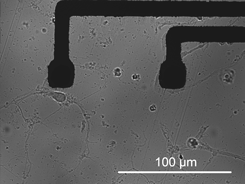Crossref Citations
This article has been cited by the following publications. This list is generated based on data provided by
Crossref.
Wang, Chunfeng
Wang, Chonghe
Huang, Zhenlong
and
Xu, Sheng
2018.
Materials and Structures toward Soft Electronics.
Advanced Materials,
Vol. 30,
Issue. 50,
Aqrawe, Zaid
Montgomery, Johanna
Travas-Sejdic, Jadranka
and
Svirskis, Darren
2018.
Conducting polymers for neuronal microelectrode array recording and stimulation.
Sensors and Actuators B: Chemical,
Vol. 257,
Issue. ,
p.
753.
Goding, Josef A.
Gilmour, Aaron D.
Aregueta‐Robles, Ulises A.
Hasan, Erol A.
and
Green, Rylie A.
2018.
Living Bioelectronics: Strategies for Developing an Effective Long‐Term Implant with Functional Neural Connections.
Advanced Functional Materials,
Vol. 28,
Issue. 12,
Kim, Youngseok
Lim, Taekyung
Kim, Chi-Hyeong
Yeo, Chang Su
Seo, Keumyoung
Kim, Seong-Min
Kim, Jiwoong
Park, Sang Yoon
Ju, Sanghyun
and
Yoon, Myung-Han
2018.
Organic electrochemical transistor-based channel dimension-independent single-strand wearable sweat sensors.
NPG Asia Materials,
Vol. 10,
Issue. 11,
p.
1086.
Pas, Jolien
Pitsalidis, Charalampos
Koutsouras, Dimitrios A.
Quilichini, Pascale P.
Santoro, Francesca
Cui, Bianxiao
Gallais, Laurent
O'Connor, Rodney P.
Malliaras, George G.
and
Owens, Róisín M.
2018.
Neurospheres on Patterned PEDOT:PSS Microelectrode Arrays Enhance Electrophysiology Recordings.
Advanced Biosystems,
Vol. 2,
Issue. 1,
Huang, Po-Chun
Shen, Mo-Yuan
Yu, Hsiao-hua
Wei, Shu-Chen
and
Luo, Shyh-Chyang
2018.
Surface Engineering of Phenylboronic Acid-Functionalized Poly(3,4-ethylenedioxythiophene) for Fast Responsive and Sensitive Glucose Monitoring.
ACS Applied Bio Materials,
Vol. 1,
Issue. 1,
p.
160.
Pranti, Anmona S.
Schander, Andreas
Bödecker, André
and
Lang, Walter
2018.
PEDOT: PSS coating on gold microelectrodes with excellent stability and high charge injection capacity for chronic neural interfaces.
Sensors and Actuators B: Chemical,
Vol. 275,
Issue. ,
p.
382.
Kundu, Avra
Nattoo, Crystal
Fremgen, Sarah
Springer, Sandra
Ausaf, Tariq
and
Rajaraman, Swaminathan
2019.
Optimization of makerspace microfabrication techniques and materials for the realization of planar, 3D printed microelectrode arrays in under four days.
RSC Advances,
Vol. 9,
Issue. 16,
p.
8949.
Moussa, Siba
and
Mauzeroll, Janine
2019.
Review—Microelectrodes: An Overview of Probe Development and Bioelectrochemistry Applications from 2013 to 2018.
Journal of The Electrochemical Society,
Vol. 166,
Issue. 6,
p.
G25.
Wu, Jhih-Guang
Chen, Jie-Hao
Liu, Kuan-Ting
and
Luo, Shyh-Chyang
2019.
Engineering Antifouling Conducting Polymers for Modern Biomedical Applications.
ACS Applied Materials & Interfaces,
Vol. 11,
Issue. 24,
p.
21294.
Zips, Sabine
Grob, Leroy
Rinklin, Philipp
Terkan, Korkut
Adly, Nouran Yehia
Weiß, Lennart Jakob Konstantin
Mayer, Dirk
and
Wolfrum, Bernhard
2019.
Fully Printed μ-Needle Electrode Array from Conductive Polymer Ink for Bioelectronic Applications.
ACS Applied Materials & Interfaces,
Vol. 11,
Issue. 36,
p.
32778.
Chen, Yue
and
Luo, Shyh-Chyang
2019.
Synergistic Effects of Ions and Surface Potentials on Antifouling Poly(3,4-ethylenedioxythiophene): Comparison of Oligo(Ethylene Glycol) and Phosphorylcholine.
Langmuir,
Vol. 35,
Issue. 5,
p.
1199.
Koutsouras, Dimitrios A.
Lingstedt, Leona V.
Lieberth, Katharina
Reinholz, Jonas
Mailänder, Volker
Blom, Paul W. M.
and
Gkoupidenis, Paschalis
2019.
Probing the Impedance of a Biological Tissue with PEDOT:PSS‐Coated Metal Electrodes: Effect of Electrode Size on Sensing Efficiency.
Advanced Healthcare Materials,
Vol. 8,
Issue. 23,
Gulino, Maurizio
Kim, Donghoon
Pané, Salvador
Santos, Sofia Duque
and
Pêgo, Ana Paula
2019.
Tissue Response to Neural Implants: The Use of Model Systems Toward New Design Solutions of Implantable Microelectrodes.
Frontiers in Neuroscience,
Vol. 13,
Issue. ,
Didier, Charles M
Kundu, Avra
DeRoo, David
and
Rajaraman, Swaminathan
2020.
Development of in vitro 2D and 3D microelectrode arrays and their role in advancing biomedical research.
Journal of Micromechanics and Microengineering,
Vol. 30,
Issue. 10,
p.
103001.
Scotto, Juliana
Piccinini, Esteban
von Bilderling, Catalina
Coria-Oriundo, Lucy L.
Battaglini, Fernando
Knoll, Wolfgang
Marmisolle, Waldemar A.
and
Azzaroni, Omar
2020.
Flexible conducting platforms based on PEDOT and graphite nanosheets for electrochemical biosensing applications.
Applied Surface Science,
Vol. 525,
Issue. ,
p.
146440.
Middya, Sagnik
Curto, Vincenzo F.
Fernández‐Villegas, Ana
Robbins, Miranda
Gurke, Johannes
Moonen, Emma J. M.
Kaminski Schierle, Gabriele S.
and
Malliaras, George G.
2021.
Microelectrode Arrays for Simultaneous Electrophysiology and Advanced Optical Microscopy.
Advanced Science,
Vol. 8,
Issue. 13,
Lieberth, Katharina
Romele, Paolo
Torricelli, Fabrizio
Koutsouras, Dimitrios A.
Brückner, Maximilian
Mailänder, Volker
Gkoupidenis, Paschalis
and
Blom, Paul W. M.
2021.
Current‐Driven Organic Electrochemical Transistors for Monitoring Cell Layer Integrity with Enhanced Sensitivity.
Advanced Healthcare Materials,
Vol. 10,
Issue. 19,
Susloparova, Anna
Halliez, Sophie
Begard, Séverine
Colin, Morvane
Buée, Luc
Pecqueur, Sébastien
Alibart, Fabien
Thomy, Vincent
Arscott, Steve
Pallecchi, Emiliano
and
Coffinier, Yannick
2021.
Low impedance and highly transparent microelectrode arrays (MEA) for in vitro neuron electrical activity probing.
Sensors and Actuators B: Chemical,
Vol. 327,
Issue. ,
p.
128895.
He, Enhui
Xu, Shengwei
Xiao, Guihua
Dai, Yuchuan
Li, Xinrong
Song, Yilin
Gao, Fei
Zhang, Yu
Xu, Shihong
and
Cai, Xinxia
2021.
MWCNTs/PEDOT:PSS nanocomposites-modified microelectrode array for spatial dynamics recording of epileptic discharges in multi-subregion of hippocampal slice.
Sensors and Actuators B: Chemical,
Vol. 329,
Issue. ,
p.
129190.






